 |
The carburetor is mixing air and fuel by letting the air passing through the carburetor body suck up a certain amount of fuel on the way.
The fuel injection system will have a throttle body (usually one per cylinder) with a butterfly valve and a fuel injector.
• The butterfly valve is adjusting the air flow to the engine (and thereby engine speed)
• The fuel injector is pressing/injecting a computer-calculated amount of fuel that is mixed with the air flow.
A fuel pump and a fuel pressure regulator is used to feed the fuel injector, and the amount of fuel injected to the engine depends on the fuel pressure and how long the fuel injector is kept open. (The fuel injector is an on/off device, so there is no regulation by opening it more or less)
Fuel pressure is kept stable by the pressure regulator, so the amount of fuel to be injected is controlled by keeping the nozzle open for a shorter or longer period.
The fuel injection computer (The ECU) will then decide how long to keep the fuel injector open.
A few ECU’s are capable of regulating the fuel pressure as well as adjusting the fuel injector opening duration. You can also find setups with more than one fuel injector per cylinder and other variations.
But these variations does not influence the basic fuel injection theory, so they will not be discussed further in this book. | Fuel Map
The ECU is supposed to keep the Air/Fuel Ratio (AFR) at the desired level in all situations, no matter the engine speed or the commands from the rider (How much the throttle valve is opened).
So the ECU will decide how much fuel to inject based on the predefined information stored in the fuel map.
The fuel map is like a big chessboard or a chart with typically 16 by 16 tiles. On one axis we have the engine RPM, on the other axis we have the throttle opening percentage.
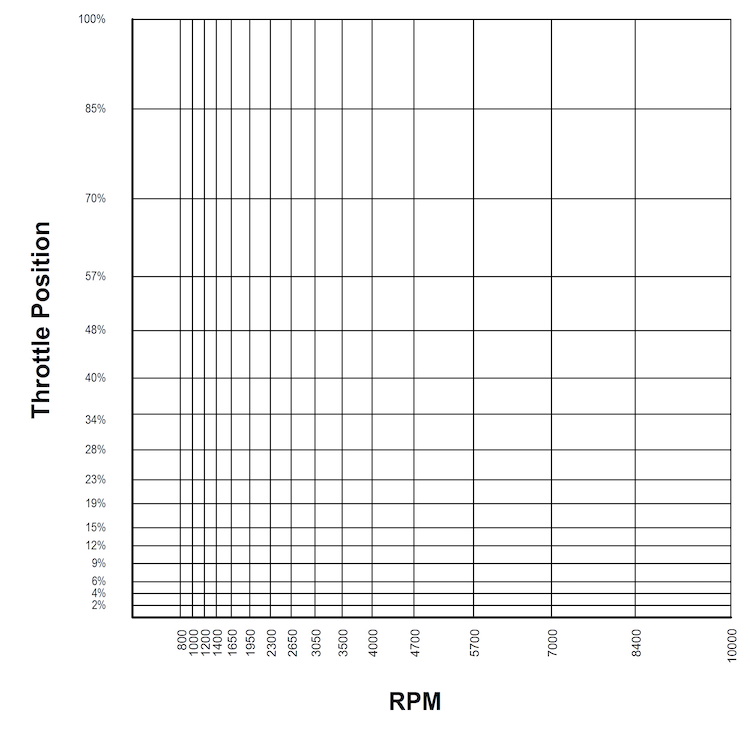
The ECU will look at the tile or cell that is matching the actual RPM and throttle valve position, and each cell contains information on how long the fuel injector should be kept open.
You will see that the cells are spaced much closer to each other at low RPM and low throttle openings. This is because this area is by far the hardest to control, so when the engine is operating in the lower left hand side of the fuel map, even the slightest shift in RPM or throttle position will require a different amount of fuel to keep the AFR steady.
As mentioned earlier, the amount of fuel to be injected is adjusted by changing the fuel injector opening duration, and the figures in the chart below is an example on fuel injector opening duration across the fuel map.

All these numbers are entered by the factory team, and this is the main programming of the ECU. If the development guys have done a proper job, the end result will be a stable AFR in all situations.
The chart below will show the result of an ideal fuel map programming. As you will see, the AFR is stable at 14,4:1 across the map.
(I’m not saying that 14,4:1 is the ideal AFR, just that the programming is consistent and therefore very good)
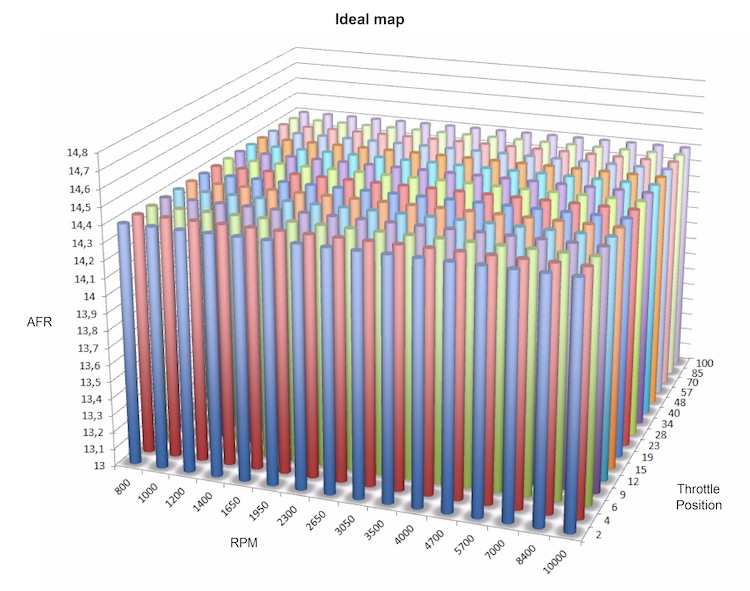
But the world is never ideal, so in reality you will see small AFR variations across the map - like in the chart below.
You will see that the AFR ranges from 14,3:1 to 14,5:1 across the map. This level of inaccuracy is common and nothing to worry about – this how a fuel map in a modern production bike will look like.
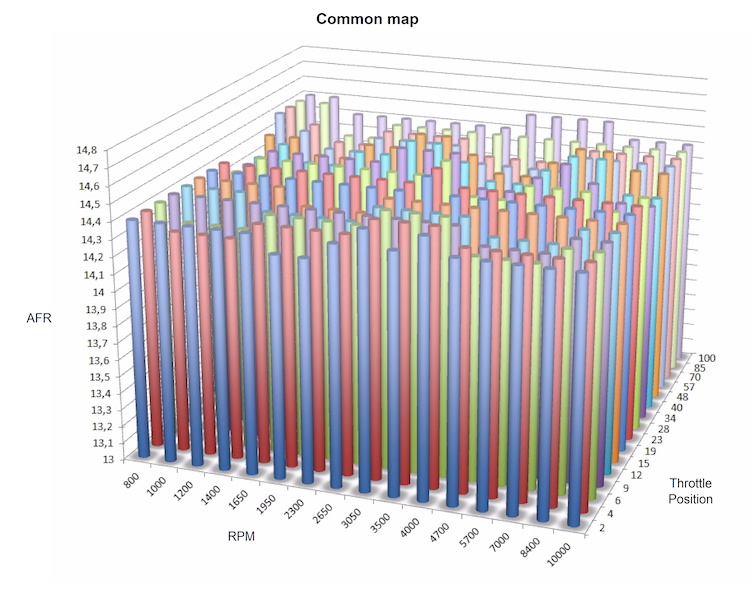
If the AFR variations gets bigger, you will experience different issues when you ride the bike: Flat spots, hesitation, misfire, exhaust popping, stalling, extreme fuel consumption, etc.
Fuel maps like the one in the chart below was not uncommon on the early generations of fuel injected motorcycles, and as you can see there are rather big AFR variations.
Some bikes were worse than others and it all depended on knowledge and experience of the factory’s R&D team. They obviously never admitted that their bikes were less than perfect, but some of them actually had horrible fuel map programming.

The tighter emission requirements in 2006/2007 forced the factories to sharpen up and invest more time in the fuel map programming, because if the map was as poor as in the example above, they could no longer get the bike approved for road use.
Some manufacturers got the fuel mapping right earlier, but quite a few of them had a steep learning curve in 2005 and 2006
So on motorcycles from 2007 and newer the basic fuel map is pretty accurate. As mentioned in a previous chapter the 14,4:1 AFR does not make the bike perfect to ride, but the mapping itself is done with a high degree of precision.
Bottom line in this chapter is that the basic fuel map already have the potential to outperform the carburetor, because you have much more precise control on the amount of fuel injection in different combinations of RPM and throttle opening. This level of control can never be obtained with a mechanical device. And even though the last generation of carburetors was developed with a 100 years of knowledge and expertise, they still found themselves outperformed by the fuel map.
But we are not done yet - By including the information from additional information sources (sensors), we can improve things further. A lot further actually!
 Additional inputs.
After the ECU have been looking at the fuel map to find the basic fuel injection amount, there will be a number of adjustments to this figure before a signal is send to the fuel injectors. This is done in the add-on modules where additional information from other sensors are taken into account.
Do make a mental note on the chart below, because I will be referring to it a lot in the following chapter.
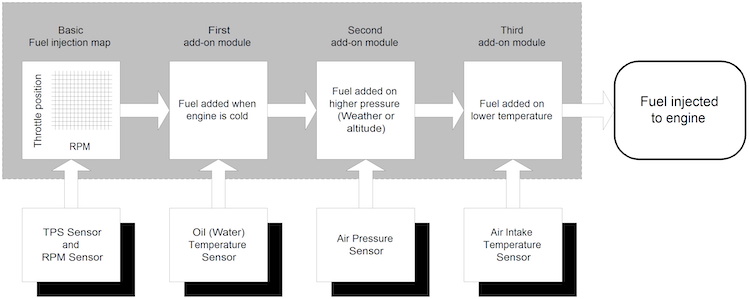
In the chart you will see the fuel injection map and the typical three add on modules. In the following I’ll take you through the three modules one by one.
Please note that the map and the add on modules are all sitting inside the ECU in a mix of hardware and software – you will not be able to find these modules anywhere on the bike
The first module is similar to the Choke on the carburetor – a device to provide a richer air/fuel ratio for starting the cold engine and when the engine is in the warm up phase. (All engines requires a richer AFR when they are forced to operate below their usual operating temperature – which they obviously must do during cold starts and warm up)
Back in the carburetor days you had a lever on the handlebar or directly at the carburetor to apply the richer mixture when you was starting a cold engine.
In the fuel injected motorcycle today, this is done automatically by the first add on module that is reading the engine oil temperature (and sometimes also the cooling water temperature), to tell if the engine is cold or not yet at it’s usual operating temperature.
This module will gradually reduce the fuel enrichment as the engine heats up, and do absolutely nothing when the operating temperature is reached.
Early fuel injected motorcycles are often equipped with a choke lever too, but this is only to allow the rider to raise the idle speed slightly during the warm up phase.
The first fuel injected bikes did not have a stepper motor to control the idle speed, so the rider had to adjust this. Today, almost all fuel injected motorcycle engines are equipped with the small stepper motor that will automatically raise idle speed during the warm up phase.
The oil temperature sensor signal was still used to make the air/fuel ratio richer, but without the stepper motor, there was no way to adjust the idle speed automatically. |
The second and third add on module is where the fuel injection is really adding value and precision to an extent the carburetor could only dream of. Now we are able to compensate for changes in the environment we are riding in, and make the bike adapt to changes in air pressure and ambient temperatures. This is one of the big advantages with fuel injection!
The second add on module will adjust the injected amount of fuel to keep the AFR steady when the air pressure changes.
Air pressure will be higher on a sunny day, and lower when the weather is poor – and higher at sea level than in the mountain passes.
Atmospheric air contains more air molecules per liter (or gallon) in high-pressure conditions that in low-pressure conditions, and the input from the air pressure sensor will allow the add on module to compensate for the changes in air pressure. This way the air/fuel ratio can be kept steady in different air pressure conditions.
Sorry if this gets a bit technical – but the essence of this is that the air pressure compensation will make your bike perform the same at sea level or in the mountains, and if you remember how bad a carburetor bike reacted to these changes you will know that this is a major improvement.
The third add on module is keeping the AFR constant when the air temperature changes.
It’s more or less the same situation as in the previous module: Cold air contains more air molecules than hot air, and the ECU is using the information from the air temperature sensor to compensate the injected fuel amount to keep the AFR steady.
This ability to provide an automatic compensation for the shifting air pressure and air temperature, gives the fuel injection an advantage that the carburetor can never compete with.
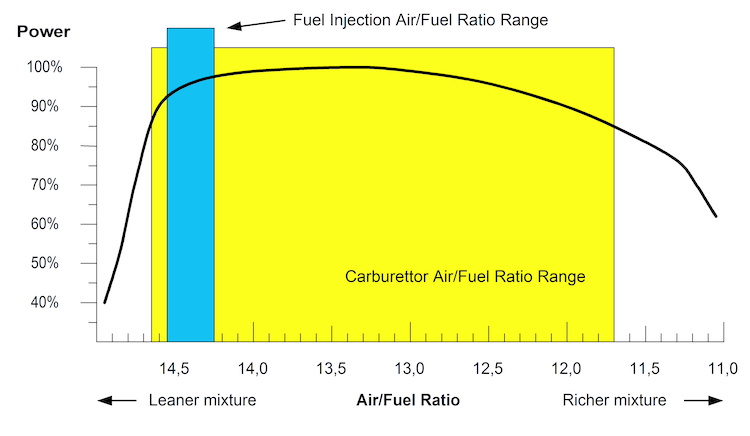
The difference in the AFR range (Accuracy) of the fuel injection and the carburetor is partly due to the use of a fuel map that gives you a better control of the AFR, but it is mainly because the fuel injection system gives you the automatic compensation for shifts in air pressure and air temperature.
With the calculations from the fuel map and the add on modules we now have a very good qualified guess on the amount of fuel to inject to the engine in all situations.
But it’s important to understand that the output signal to the fuel injector is a predetermined calculation, based on various inputs. This is called open loop operation.
We do not have any feedback from the engine if the air/fuel mixture that is fed to the engine is actually correct.
This is already far better and more precise than what can be achieved with the carburetor and this is how most early fuel injections worked. But it is still not 100 % perfect because of the tolerances in the component specs.
 Tolerances in components
All industrial components have a certain tolerance in the output. Some of them are really accurate where other will have a bigger variation in output. Here are some typical tolerance figures:
• Fuel injectors 0-1 %
• Fuel pump pressure regulator 3 %
• RPM sensor 0 %
• TPS sensor 1 %
• Air pressure sensor 3 %
• Air temperature sensor 1 %
This does not mean that all air pressure sensors are 3 % off, but the sensor will be approved in production if it is delivering an output within +/- 3% of the spec sheet figure.
Most of the components are performing close to the specs, and if you sum up all the tolerances of the involved components, you will usually see that some variations will make the AFR slightly richer, some of them slightly leaner, so the end result is fairly good on most bikes.
But if all the components on your bike was at the maximum tolerance and they was all pulling the AFR in the same direction you could have a bike that is running 8% leaner or 8% richer than the preprogrammed value.
It will be very few of the bikes that are running extremely rich or lean, but most of them will have a smaller or larger offset compared to the programmed AFR.
Without the current emissions restrictions, this would never be a problem, because the end result is so much better than what a carburetor can deliver, but as the manufacturers are forced to run the bikes very lean (very close to the border where your engine will stall or destroy itself long term), the small AFR variation is not acceptable.
So if you looked at a random selection of a hundred production bikes you would see a pattern like this:
• Most of the bikes would be more or less OK, but slightly different due to the tolerances in the fuel injection components.
• A handful of them would be running very lean, overheat, stall the engine at every stop and in general be very unpleasant to ride.
• Another handful of bikes would be running way richer than the target AFR and would be much more pleasant to ride – but would not pass the environmental tests.
This is obviously not ideal, and after the introduction of the tighter environmental standards in 2006/2007, the full Open Loop fuel injection system was no longer precise enough to meet the new standards.  | | | | | |





